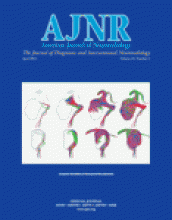Bracard et al (1) present the results of a retrospective study on endovascular treatment of patients with Hunt and Hess grade IV and V aneurysms during a 6-year period. Their conclusion is that early endovascular treatment of high-grade subarachnoid hemorrhage (SAH) is a viable alternative to surgery and that “clinical outcomes have proved to be at least as good as those obtained by surgery, with a higher number of patients enjoying very satisfactory recovery.” This last conclusion seems to be true only for patients with grade IV aneurysms, however, because the mortality of patients with grade V aneurysms is 63% (15 of 24 patients treated) and a favorable outcome was obtained in only 29% of cases (7 of 24 patients). These results are comparable with those of reported surgical series (for review, see 2).
We recently presented the results of a prospective study of the endovascular treatment of 11 patients with SAH WFNS grade V admitted during a 12-month period (2). Although the WFNS scale and the Hunt and Hess scale are not identical, there is a very good correlation, and patient distribution is comparable. All WFNS grade V patients were included in our study unless brain stem reflexes were absent or an aneurysmal intracerebral hemorrhage mandated surgical evacuation. Inclusion criteria were a Glasgow coma score between 3 and 6 after resuscitation, without improvement after ventriculostomy in the case of hydrocephalus. The treatment protocol consisted of early endovascular occlusion of the aneurysm followed by aggressive treatment of intracranial hypertension and prevention of vasospasm by routine hypertensive hypervolemic hemodilution therapy. Ten patients were treated within 24 hours, most of them receiving treatment within 8 hours after the SAH. Most of the patients (55%) reached a favorable outcome; the mortality rate was 18%. Compared with published surgical and other endovascular series, our results were quite favorable.
We believe the difference in outcome between Bracard et al’s study and our study for grade V patients is mainly due to our more aggressive early preventive treatment of vasospasm. Vasospasm as a cause of delayed ischemic deficit is more frequent in poor-grade patients and is the most important cause of morbidity and mortality. Optimal treatment in the initial phase after the SAH may be crucial to preserve the viability of the already compromised brain. This optimal treatment includes early occlusion of the aneurysm to prevent rebleeding and to allow appropriate prevention of vasospasm by optimizing cerebral perfusion. This is confirmed in a surgical series of poor-grade patients as well (3); however, surgery in poor-grade patients is often difficult and has the risk of inflicting further damage to the already edematous and ischemic brain by retraction and manipulation of cerebral vessels. Therefore, the combination of early endovascular treatment causing minimal additional damage and aggressive intensive care for optimal cerebral perfusion may lead to the best results for these patients. Thus, even patients in very poor clinical condition after SAH have a fair chance of experiencing favorable outcomes. Because no admission finding is a sufficient absolute predictor of favorable or poor outcomes in patients with aneurysmal SAH, we suggest that all patients be treated unless brain stem reflexes are absent.
Reply
We would like to thank Doctor van Loon and Wilms for their comments and for reminding us of their studies of which we were unaware when we wrote our article.
As their prospective series shows, mortality is indeed lower with early treatment and aggressive initial therapy. Intervention in some of our patients could not be performed as quickly or aggressively as we would have liked.
Quality and speed of treatment appears to be the most significant factors for favorable outcome. Vasospasm remains a major problem because of the difficulties in confirming a diagnosis in unconscious patients, but it cannot account entirely for the discrepancy between our series and that of van Loon and colleagues.
Dr. van Loon and Wilms are to be congratulated for their excellent results. We fully agree that endovascular treatment combined with preventive measures and aggressive treatment of hemorrhagic complications is certainly the best current therapeutic method.
Yours sincerely,
Professor Serge Bracard
- Copyright © American Society of Neuroradiology












